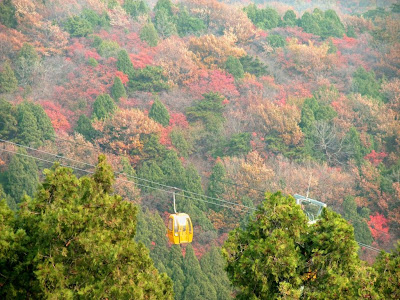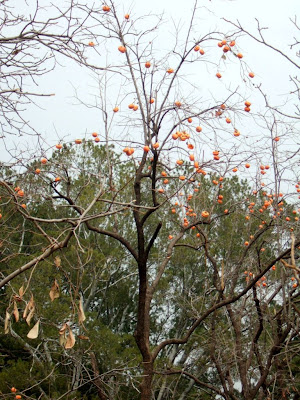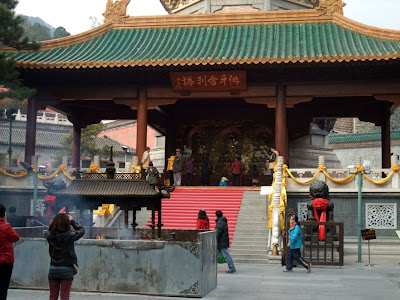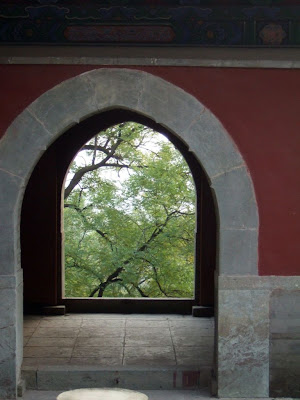
The Eight Great Sites Park, also well known as Badachu, is a scenic area with beautiful forest and mysterious temples at the foot of Beijing's Western Hills. A natural sight with complex of monasteries covering a total land area of 253 hectares, attracts crowds of people in every season to come and enjoy the stunning scenery and feast their eyes with its beautiful sights.



scattered across the hills of Cuiwei, Pingpo and Lushi, namely
(1) Changan-si 长安寺 - Temple of Eternal Peace
(2) Linguang-si 灵光寺 - Temple of Devine Light
(3) Sanshan-an 三山庵 - Nunnery of 3-Hills
(4) Dabei-si 大悲寺 - Temple of Great Mercy
(5) Longquan-an 龙泉庵 - Nunnery of Dragon Spring
(6) Xiangjie-si 香界寺 - Temple of Fragrant World.
(7) Mingzu-dong 明珠洞 - Precious Pearl Cave
(8) Zhengguo-si 证果寺 - Temple of Thoroughly Transform



The splendid sight of the hills in fall.


The highest peak within the hills is 464 meter, accessible by foot hiking or cable car. Most beautiful sight of the hills is when leaves turn red, during autumn period.



Nearly 98% of the area is covered with vegetation.




There are about half million of old trees within the site and some trees have been standing there for over six centuries, with roots and branches remaining in good shape.


Badachu is a mountain park nested amidst Cuiwei, Pingpo and Lushi hills, but rich in Buddhist Temples atmosphere. Currently it is one of the primary groups of major historic sites under provincial protection.


The 8 old temples at Badachu were constructed in Tang, Song, Yuan and Ming Dynasties respectively, and five of them were built under the order of Emperors. After repairs, reconstruction throughout the history, the ancient architecture of these structures were still quite well preserved.



The site of Badachu was destroyed by the eight nation alliance forces in 19th century but was then restored and repaired after founding of People's Republic of China in 1949.



Badachu is a famous local tourists attraction that is the nearest to the Capital city and further it has a mild winter and cool summer, with vast areas of vegetation including thousand years aged trees with abundant branches and strong root.




Linguang-si was originally built during Tang Dynasty between years 766-779 with 5 complex of halls but now remain only three, one of which hold the time-honored base of thousand Buddha status pagoda dating back to Liao Dynasty. It is the most important preserved temple in Badachu. The copper image of Shikhamuni Buddha housed in The front gate hall was presented by Thai King.



The Liao Dynasty built Pagoda was destroyed by eight nations alliance forces in 1900. Fortunately the tooth relic of Buddha remained safe in a stone case at the base of the ancient Pagoda. It was found out by monks while clearing the mass. The Pagoda was approved to restore at the same site to house the precious and holy Buddha's tooth relic, which remains only two in the world. The other one is in Sri Langka.




The Buddha's tooth relic is now housed and worship at the present Pagoda which was restored on the same site of the ancient one upon the approval of Chinese former Prime Minister Chao-En-Lai.




The towering Pagoda with a Buddha's tooth relic.







I recited the Buddha's name and at the same time, circled the Pagoda in clockwise direction for three rounds, followed by bowing to the Buddha's relic three times. As a Buddhist, I believe that by doing so, I would receive great blessing and great benefits at least no misfortune or disaster would happen to me and my family.




This hall housed a Medicine Buddha's image made from pure white jade, offered by a Myanmar Government officer and his family to wish for a peaceful world.



The restored reclining wall was built to accommodate the growth of an ancient tree from the mountain cliff.



Many people came to the huge 500 Arahat Wall and Heart Sutra Wall to make their prayers or wishes.



The replica of Buddha in meditation (Sammadhi) placed in front of the Arahat wall, was presented by the President of Sri Lanka on 27th February 2007, marking the 50th anniversay of China-Sri Lanka diplomatic relations.




Nunnery of Sanshang-an, located at the center of the three hills, was built in year 1151 with a complex of monasteries. The image of Shikhamuni Buddha was housed in the main Shrine Hall. The famous incident relating to the temple was happened in Qing Dynasty when a noble monk studied Buddhist Dharma and did meditation here and later transmitted all his gains in experience and research in writing and published in books.



Dabei-si is noted for the 18 lively Arahat images in Hall of Mahavira, molded during Yuan Dynasty (1271-1368) by a renowned sculptor named Liu Yuan. He used the grounded sandal wood powder to mix with materials used for the images. There is still some kind of fragrance floating in the air of the main hall until today.



By north west direction of Dabei-si, stand the nunnery Longquan-an. It was first built during Ming Dynasty in year 1425 completed with five building complex in 3 layers. In year 1645 during Qing Dynasty, an addition hall was built to worship the King of Dragon, when flow of spring water was found at the site.




The underground water was kind of mineral water and never ever dried up since found.



The mineral water well.



Behind the comparatively small entrance door is a square pond. The water is ceaselessly surged forward from the mouth of a dragon head.



The mineral water was directed to this square pond from the mouth of a dragon head.


Beautiful brocade carps swim delightedly in the liberation pond.



The two important structures at Longquan-an is the main shrine where an image of Dragon King was housed and to its north direction is the Longquan Tea House. The tea house has long history and was quite influencing in the Capital City. Their tea is made from the underground natural mineral water and its distinctive taste is the love of many tea lovers. Many visitors while admiring the scenery, would stay here for a while to enjoy a cup of its tea.


Xiangjie-si lying against Pingpo Hill, is the largest monasteries complex in Badachu. It was established during Tang Dynasty (758-760) and had been a resting resort for most of the Emperors when they traveled to the mountains.


Long sloping stairway to Xiangjie-si, the 5th temple we were going to visit. Though climbing up and down, bowing and praying from one temple to another required a lot of energy, we enjoyed admiring the arbor and rare ancient trees and the beautiful scenery together with the locals, along the way up.


There are three main sites at the Temple complex. The Hill Gate Hall is at the center hanging with a stone plague inscribed with "Xiangxie-si Built by Order of Emperor"


Images of 18 Arahats and three Buddhas of the Past, the Present and the Future were housed in the main shrine hall.


The ancient pine trees at the second layer of buildings complex, behind the Hill Gate Hall were described as dragon pines due to its abundant branches. On the left and right side of the area are bell and drum towers. The stone plaque inscribed with two Chinese character "Jing Fo" which means respect the Buddha, was written by Emperor Kangxi of Qing Dynasty. It was erected in front of the Main Shrine hall. In the main halls, there are also another two steles with dragon and tortoise bases bearing with inscription written by Emperors Kangxi, Qianglong and Jiaqing of Qing Dynasty.




A corner in Badachu hills valley was specially developed into an open cultural art section in this scenic site, to exhibit the stone carving arts. The natural rocks were carved with seal scripts and designs basing on thousands of important ancient seals of different eras.


The rocks carved with ancient seal scripts and designs were placed in sequence in accordance to their era, at different elevations, from high to low parts of the valley. There are divided into eight sections marking works from different dynasties from Chin to Qing period. Various work include scripts of practical seals, official seals, private seals of people in fame, and most importantly, it is an accumulation of art pieces or painting works from hundred over famous artists and calligraphers of various generations.




Seal Carving which has been included in the 4 tradition arts of Chinese (Painting, Calligraphy, Poetry and Seal Carving), is a long history ancient art and it is closely associated with Chinese writing. The seal reflected ranges of Chinese characters which have been developed into many different scripts or styles over the long history. Commonly used for seal scripts was Zhuan style.



The earliest seals ever found in China are the three ancient seals found in Anyang, an ancient capital in Shuang Dynasty (1766 BC - 1154), which were believed most probably to be from that period of time. Seals became practical and popular during Warring States (474 BC - 221). It matured and flourished in Han Dynasty (206 BC-23 AD) and since then it has been gradually turned into an indispensable item for signing the important and legal documents, as well as an integrated part of a Chinese artwork of painting or calligraphy.


Function of Seals changed over different dynasties. Some seals were created as their practical functions and some were made particularly as works of art and of course, there are seals made to serve for both purposes. Traditional Chinese stamping seals are quite versatile, typically there are name stamps, words or phrase stamps,or official stamps. An official seal represents the office and power.



Stamping seals are still playing an important role in the daily life of Chinese people. They are required for signing official and important documents. But as an ancient art Seal Carving is till much appreciated by many Chinese people. In recent years, the prices of some rare seals have risen to sky high in China.



Zhenguo-si is the oldest temple in Badachu. It was originally built in Tang Dynasty or perhaps earlier during Sui period. The copper bell engraved with Heart Sutra at the main shrine hall was molded in year 1470 and many of its ancient trees carry a history of 600 years. The temple complex sits at the mid way of Lushi Hill facing south direction with Hill of mysterious Demon at his northern side.



Towards the west direction of the small courtyard in Zhengguo-si, there is a huge rock hanging halfway in the air, as if flying from the outer world, and by its side, is a natural cave with images of three noble monks. It was said that the monk named Rev. Lushi did his retreat here. He used to help the farmers by using his power to invoke for rain and was honored by Emperor as a "Responsive Zen Master" .




Hill of mysterious Demon.





Unexpectedly, we had one of the most interesting breakfast from this store, situated just near the bus station when we were heading for Badachu. The crispy wrapper was made from mixed grains with eggs on the spot. It was immediately spread with some homemade sauce after ready, and then folded up with assorted green vegetables, grounded nuts and seeds or some meat floss. It was cheap, tasty and healthy.



The red five-stars China national flag fluttering in the air at all corners.


No comments:
Post a Comment